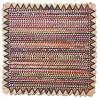Quilt No.127MOV - Museum of Victoria
2160 x 2160mm
Made by Elizabeth Hawkey in Clunes, Victoria. The quilt remained in the Hawkey family and was owned by Mrs Nancy Vibert, great grand-daughter of Elizabeth Hawkey. Mrs Vibert gave the quilt to Beth Chamberlain of the Goulburn Valley Quilters Group, Shepperton, in 1988. The Group donated the quilt to the Museum of Victoria in 1992.
Elizabeth Hawkey was born in Cornwall in 1829 and died in Clunes (Vic) in 1909. She married Simeon Hawkey in Cornwall in 1850. Elizabeth came to Australia with four children on the 'Royal Standard' on 27th September 1866 and arrived on 17th December 1866. Simeon was already in Australia.
Simeon and Elizabeth had a store in Clunes and it is here she made the quilt.
"The quilt was the property of Mrs Nancy Vibert of Shepparton, great grand-daughter of Elizabeth Hawkey. Mrs Vibert recalls sleeping under the quilt as a child, as did her mother, it was well loved and used. However Mrs Vibert felt it had reached the end of its useful life and was preparing to 'throw it out' when her grand-daughter protested and said she thought it was of historical interest and 'surely someone would want it'! Mrs Vibert contacted Beth Chamberlain of the Goulburn Valley Quilters Group and eventually gave her the quilt.
Beth took the quilt to a meeting of the G.V.Q.G towards the end of 1988 and some of the members took it to a meeting of the Australian Quilters assn in Melbourne. Everyone thought it was a wonderful old quilt but nobody quite knew what to do about it.
In 'Quilts Down Under' Beth read about the conservation of the Elizabeth MacArthur quilt and discovered that the conservator, Glennda Susan Marsh, was now living in Yarrawonga. She visited Glennda with the quilt and subsequently received the � report.
Shortly afterwards Beth arranged for the qult to be seen by Elizabeth Willis, Curator, Social History, Museum of Victoria at a seminar in Benalla. Elizabeth wrote to say that it was a most interesting piece and well worthy of conservation.
The information was conveyed to the Goulburn Valley Quilters Group and several members indicated that they would like to take part in its conservation. It was decided to ask Glennda to join us � to advise us on how best to go about the conservation. ���.
After an initial meeting to plan our 'attack' and subsequent decisions were made, work really began on 4th Sept. People were able to come and go as they pleased bearing in mind Glennda-Susan's advice that an hour at a time was possibly long enough to work on it, as it was very painstaking. Fine long beading needles were used and very fine synthetic thread. Every tiny piece of worn fabric was carefully stitched down on to the blanket. Much of the blanket had to be darned before the pieces could be stitched down and this darning was done by Beth using unravelled threads of an old blanket that had been her mothers.
The quilt conservation was finally completed in December, 1990.
On Australia Day 1991 it was displayed on a bed in the Shepparton Museum, for a special Australia day Ceremony. During the year it was displayed at various quilting events including our own Exhibition in November.
We would have liked the quilt to stay in Shepparton but realized our Museum did not have the necessary facilities to store such a precious piece we were overjoyed when it was accepted by the Museum of Victoria.
[Extract from notes supplied by Museum of Victoria. Original source, The Goulburn Valley Quilters]
Related Quilts:
The backing is maroon cotton. 1600 x 1600 mm.
The quilt is of three layers because the strips of the log cabin are attached to a backing piece, and then the quilt is lined; however it is not padded." [NGA]
1400 x 930mm
1570 x 152Omm
Quilt is hand pieced.
1000 x 1000mm






